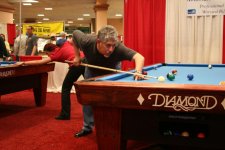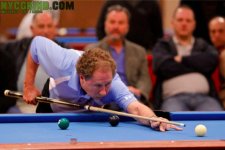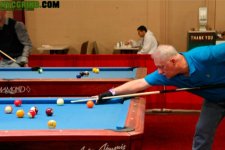Some random thoughts.
Having bought various sets over just the last few years I can report that:
Centennials come with a blue circle;
Super Pros come with a red logo;
Tournaments with a black logo;
and the TV set comes with the measles ball.
What an excellent thread this has turned out to be! Lou's info is spot-on. Notice that NONE of these most common sets come with a Red Circle. (I don't have any information about the Vigma sets, so I don't have information to share on them -- perhaps some of our friends in Germany might be able to share some insight?)
About a year ago I was told by Cigar Dave that the way to tell the difference between a real measles ball and a fake was as follows:
"The real one has a higher coefficient of restitution (CoR). I have a counterfeit one so I know. The higher the CoR, the more efficient the collision.
Do this test.
From eye-level, simultaneously drop both balls onto a smooth concrete floor. The real one will bounce ~8" higher than the counterfeit one.the way you tell the difference between a real measles ball and a fake is to bounce them simultaneously on a hard surface (i.e. concrete floor) from waist height and, the fake will bounce far less due to the resin used and a different coefficient of restitution."
I'd heard about this test, but it's nice to have documented -- in one place -- how to conduct this test and what to look for.
I suppose that if you only practice or play at home you can choose to play with whatever cue ball you like. But out in the real world you most usually will find the red circle in play and you might as well get used to that. Besides, if you’re playing with the locals chances are they’re going to look askance at playing with anything out of the norm. This is particularly true if you plan on ever enticing any of the them into playing something other than 14.1, like say a friendly game of 1pocket. Even in the 14.1 Challenges I’ve seen at the Philly Expo, DCC, and US Open in Vegas, it’s always been the red circle.
The bolded part is incorrect. That I can speak to with authority. They use the measles ball in the SBE 14.1 Challenge. You will find NO red circle balls here.

And, for the rest, it depends on what you're training for. If you're practicing for some of the major tournaments (e.g. SBE Open/Pro 10-ball, or any 14.1 tournament of any notioreity, and many others), it make sense to practice with the cue ball standardized with that tournament spec. That most often will be the Blue Circle or the Pro Cup (measles ball). 14.1 enthusiasts and practitioners will demand nothing less.
But if you're only interested in your local 9-ball tournaments, *of course* practicing with the red circle makes sense, since it's the favorite cue ball of that discipline.
Which brings up an interesting point: why would anyone override the cue ball that comes standard with ball sets, and choose a cue ball that HAS NEVER been included standard with ball sets precisely because it's so different? The next quote segues nicely...
I recently bought a set of Super Pros and a new Aramith red circle (of course there are fake versions of these out there too -- so buy from a reputable dealer who specifies it is indeed from Aramith).
It's always struck me as interesting why anyone would want to do this, especially a 14.1 or one pocket practitioner. And this is especially interesting considering how many pool rooms do this. What happens with all those red-/black-logo'ed, blue circle, and measles balls that'd been swapped out? Are they put back on the market? Are they saved as "oh my gosh, I'm really sorry about this, but this is the only cue ball we have left" emergency replacement for red circles that'd suddenly disappeared? Mulder, you have an interesting X-file to bring to Scully!
I was surprised how much larger it is from the red circle I’d been using. The previous was my own ball that I’d bought new just a few years ago and which received far less use than a pool hall ball. So what this tells me is that a cue ball probably loses size much faster than I ever suspected. And if you think about it in terms of your chalked tip having at least the abrasiveness of, for the sake of argument, 600 sandpaper, and the 10’s of thousands of blows it takes over the course of just one year, it makes a certain amount of sense. So now, playing with the new red circle, my general feeling is that it plays much more like a measles ball. I always felt there was a more dramatic difference, but that may have just been the difference in size.
Lou Figueroa
I have a feeling that the bolded part is due to Saluc's "dammit, we're tired of all these cue ball differences over the years. That does it, we're going to use the same resin and manufacturing technique for all cue ball products moving forward" standardization. This is a standard "product assimilation" technique utilized by the whale that swallows another whale. I'd witnessed several of these acquisitions personally:
- Digitial Equipment Corporation is swallowed up by Compaq, which is swallowed by HP
- CNS group merges with 3 other companies to form AimNet Solutions, which is swallowed by Cognizant Technology Solutions (all three are my former employers)
- Sun Microsystems is swallowed up by Oracle
- Computer Associates is known as the "Borg" in information technology circles; a playful pun on their "Better Software by Design" is "Better Software through Acquisition"
In each case, each of the swallowed companies' products were hacked-down, and then standardized into the larger company's product line.
The pool industry is NO different -- it's just another take on the corporate world. Saluc standardizing the blue circle, red
logo, and measles ball (save for any perceptible size difference in the measles case) would be due to this standardization. (The black logo ball is a different story, due to the different resin -- Duramith -- used in the Tournament ball sets.)
I would not be surprised if the red
circle -- going forward -- turns out to be the same cue ball as the red logo, blue circle, and measles ball in future products.
It's bound to happen.
-Sean




